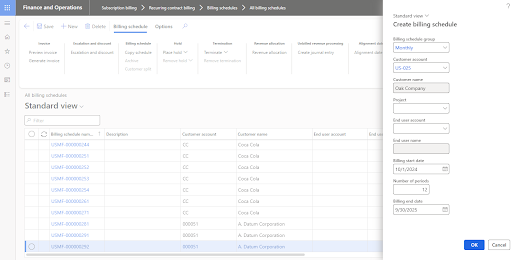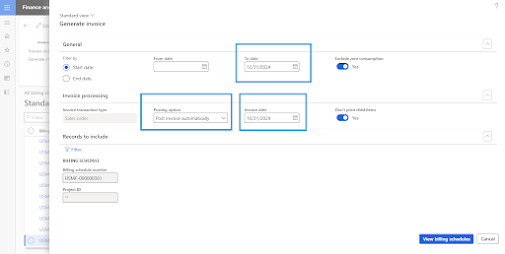SEGREGATING RESPONSIBILITIES IN VENDOR INVOICE PROCESSING
CONTENT
Introduction SOD business process flow in Vendor Invoice Processing Prerequisites for Implementing SOD in Vendor Invoice Processing Scenario 1: Processing a service invoice Scenario 2: Processing an inventory invoice Conclusion |
Introduction
Segregation of Duties (SOD) is a foundational principle in internal control that ensures critical tasks within business processes are divided among multiple individuals. This division of responsibilities helps prevent fraud, errors, and conflicts of interest by reducing the likelihood of any one person being in control of all parts of a transaction. It is particularly relevant for financial operations, where sensitive transactions such as vendor invoice processing must be handled with care to maintain compliance with regulations such as SOX (Sarbanes-Oxley Act) and safeguard the organization from financial mismanagement.
Microsoft Dynamics 365 Finance (D365 Finance) integrates SOD principles throughout its workflows, ensuring that organizations can enforce these controls systematically. Vendor invoice registration and processing, in particular, benefit from D365 Finance’s robust SOD capabilities, allowing businesses to create clear separation between invoice registration, matching, and final posting activities.
Before going into the technical details of vendor invoice processing in D365 Finance, it is essential to understand why SOD is critical for businesses. By enforcing SOD:
- Risk of Fraud is Minimized: When key duties like approval, execution, and verification are split across multiple individuals, it becomes much harder for anyone to manipulate the system without detection.
- Error Detection is Enhanced: SOD reduces the likelihood of undetected mistakes, as different eyes are involved in various steps of the process, providing opportunities for checks and balances.
- Compliance Requirements are Met: Regulatory frameworks such as SOX mandate SOD as part of their requirements for financial reporting integrity, and failure to implement these can result in penalties or reputational damage.
In vendor invoice processing, SOD plays a key role by ensuring that the registration, approval, and posting of invoices are handled by separate personnel, or at least separate workflow processes, reducing the chance of unauthorized or erroneous payments.
SOD business process flow in Vendor Invoice Processing
Microsoft designed Dynamics 365 Finance screens and workflows with built-in SOD principles to streamline the segregation of duties in processes like vendor invoice registration and approval. Let's explore how this process works within D365 Finance, focusing on the distinct stages of Registering, Matching, and Posting.
1. Registering the Vendor Invoice
The purpose of the invoice registration stage is to capture the invoice details without fully committing them to the financial ledgers. This temporary registration helps organizations maintain an organized workflow where invoices are captured as they arrive but are not yet officially posted. The SOD principle here is that the person responsible for registering the invoice does not have the ability to approve or post it.
In Dynamics 365 Finance, you can either register invoices manually or through automation. The manual registration process involves creating a journal entry, inputting minimal details such as the invoice number, vendor, and total amount.
This flexibility allows businesses to set up Power Automate integrations or other data entities to streamline the registration process. The key benefit of automation here is that it reduces manual data entry, allowing invoices to flow seamlessly into the system while still maintaining SOD principles.
At this stage, there is no need to match the invoice to a purchase order (PO), allowing for a quick and efficient way to capture the total invoice amount without being bogged down by details.
2. Matching the Invoice to Purchase Orders
Matching invoices to purchase orders is crucial for verifying that the goods have indeed been ordered and received. This step not only ensures the accuracy of the invoice but also reinforces SOD principles by requiring different individuals or workflows to handle the verification of the goods or services received.
During the matching phase, the system cross-references the invoice with the relevant purchase order and/or product receipts. In D365 Finance, the system can automatically match these documents, reducing the chance for manual errors. If a discrepancy is detected, it needs to be resolved before proceeding to final posting.
3. Posting the Invoice
Once the invoice has been registered and matched, it moves to the final stage of posting, where it becomes a permanent record in the financial system. Posting invoices involves applying the correct expense accounts and ensuring all relevant checks have been completed. The segregation here ensures that the person posting the invoice is not the same individual who registered or matched it.
In Dynamics 365 Finance, the invoice approval screen facilitates the final posting. The system brings all the required account information automatically, and the user responsible for posting merely needs to review and approve the details.
Prerequisites for Implementing SOD in Vendor Invoice Processing
Before implementing the segregation of duties (SOD) principles in vendor invoice processing within Dynamics 365 Finance, there are a few key configurations that must be set up to ensure a smooth workflow. Below are the essential prerequisites:
- Invoice Register Journal Type Creation: This journal type is necessary for the temporary registration of invoices. It allows the system to capture the invoice details without immediately posting them. Follow these steps to create it: Navigate to General ledger > Journal setup > Journal names. Create and configure the journal for invoice registration.
- Invoice Approval Journal Type Creation: The invoice approval journal type enables the retrieval and final posting of previously registered invoices. This setup is critical for separating the registration from the approval and posting processes: Go to General ledger > Journal setup > Journal names. Create the appropriate journal for invoice approval.
- Vendor Posting Profile Setup: Vendor posting profiles dictate how the system posts transactions to general ledger accounts. For the invoice registration process, you need to configure a temporary vendor account and offset account: Navigate to Accounts payable > Setup > Vendor posting profile. Set the Arrival account to a temporary vendor account and the Offset account to a temporary offset account.
Let’s consider a typical situation where three different individuals are responsible for the stages of processing a vendor invoice.
Emma is responsible for registering the invoice.
John handles matching the invoice with the Purchase Order (PO) and Product Receipt.
Sophia is responsible for the final posting of the invoice in the financial system.
SCENARIO 1: Processing a service invoice
Invoice Registration by Emma: Emma works in the accounts payable department, and her role is to register invoices as they arrive. Today, she receives an invoice from a vendor for a batch of products ordered by the company. Emma’s responsibility is to input the invoice details into the system without finalizing the transaction.
In Dynamics 365 Finance, Emma follows these steps:
Go to Accounts payable >> Invoices >> Invoice register
Click on +New and select a (invoice registration) journal name
Create a journal line.
Emma enters the vendor account, invoice number, date, and total amount of the invoice. At this point, she does not match it with any purchase order.
Once the details are entered, she posts the invoice as temporarily registered in the system.
Posted journal voucher is as below
A voucher is created, and the system logs the invoice in a way that allows it to be reviewed and processed later. This voucher’s account setup is done in the vendor posting profile as explained in the prerequisites section.
Emma’s role is now complete. Her responsibilities ensure that invoices are captured in the system quickly but without granting her the ability to finalize or post them.
Invoice Posting by Sophia: Finally, Sophia, who works in the finance department, is responsible for approving and posting the invoice after all checks have been completed. Sophia’s task is to review the details entered by Emma before completing the posting process.
In Dynamics 365 Finance, Sophia performs the following:
Go to Accounts payable >> Invoices >> Invoice approval
Click on +New and select a (invoice approval) journal name
Empty screen comes up, click on Find vouchers to find temporal posted invoices.
Find the invoice by clicking on Find vouchers.
Select the invoice and click on Select button and then OK button.
Once the relevant invoice is found, she reviews the accounts and details automatically populated by the system. She enters the appropriate expense account to which the invoice will be posted.
Click on Post.
Posted voucher is as below:
SCENARIO 2: Processing an inventory invoice
This scenario is different from the previous one. In addition to the steps in the first scenario, this process includes matching the purchase order (PO) and product receipt before posting the invoice.
Invoice Registration by Emma: Emma works in the accounts payable department, and her role is to register invoices as they arrive. Today, she receives an invoice from a vendor for a batch of products ordered by the company. Emma’s responsibility is to input the invoice details into the system without finalizing the transaction.
In Dynamics 365 Finance, Emma follows these steps:
Go to Accounts payable >> Invoices >> Invoice register
Click on +New and select a (invoice registration) journal name.
Create a journal line, enter the vendor account, invoice number, invoice date and invoice amount.
Click on post.
Posted journal voucher is as below.
So far, invoice has been temporarily registered and there is no purchase order relation.
This voucher’s account setup is done in the vendor posting profile as explained in the prerequisites section.
Invoice Matching by John: Next, John, who works in the procurement department, is responsible for ensuring that the invoice details match the relevant purchase orders and product receipts. In this case, the invoice pertains to an order that was placed last month, and the products have already been delivered.
John performs the following actions:
He navigates to Accounts payable > Invoices > Invoice pool, where the temporarily registered invoices are listed.
Click on Purchase order and select the PO number.John selects the corresponding invoice and then clicks on Find purchase orders to locate the purchase order associated with the invoice.
System creates a pending invoice on the invoice pool screen. Click on Match product receipts.
Match the product receipt by clicking on Match product receipts.
Perform invoice matching by clicking on Update match status.
John's role ensures that the goods or services invoiced are properly matched against what was ordered and received, adding a crucial layer of verification in the process. He does not, however, have the authority to post the invoice.
Invoice Posting by Sophia: Finally, Sophia, who works in the finance department, is responsible for approving and posting the invoice after all checks have been completed. Sophia’s task is to review the details entered by Emma and the matching done by John before completing the posting process.
In Dynamics 365 Finance, Sophia performs the following:
Go to Accounts payable >> Invoices >> Invoice approval
Click on +New and select a (invoice approval) journal name.Empty screen comes up.Sophia clicks on Find vouchers to locate the invoices that have been matched but are pending approval and posting.
Select the invoice and click on Select button and then OK button.
System automatically brings all accounts to be used for the posting. Enter the expense account here.
Go to pending vendor invoices.Accounts payable >> Invoices >> Pending vendor invoices.
Find the invoice and click on Post.
Posted voucher is as below.
Conclusion
This clear segregation of duties ensures that no one individual has control over the entire vendor invoice process. By splitting the process into distinct responsibilities—registration, matching, and posting—the organization minimizes the risk of fraud or error. Each person involved has a specific role and responsibility, contributing to the integrity of the financial data and reducing the likelihood of internal control failures.









































































